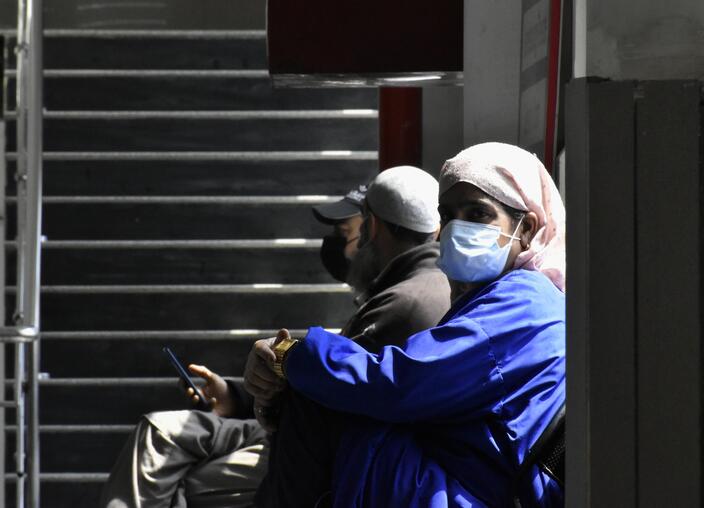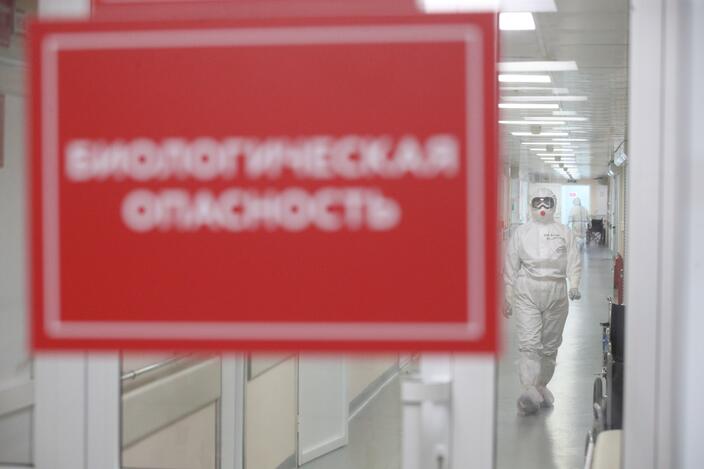Photo: © Izvestia/Sergey Konkov

Photo: © Izvestia/Sergey Konkov
A new subspecies of the omicron strain “Eris” has also reached Russia. From April to August 2023, 17 cases of infection were detected in our country. The infection was found in patients from Moscow, St. Petersburg, Buryatia, Khakassia, Irkutsk and Magadan regions.
Meanwhile, in Britain, “Eris” has already become the second most common subspecies of COVID-19 after “Arcturus”. The virus is behaving so aggressively that the West is seriously afraid of a new wave of coronavirus.
Virologist Nikolai Kryuchkov told REN TVhow dangerous the new subspecies of the omicron strain “Eris” is and whether a major surge in incidence can occur in Russia.
“Eris” reached Russia
In Russia, 17 cases of infection with the Eris omicron strain have been identified. A new subspecies of COVID-19 was found in patients from Moscow and the Moscow region, St. Petersburg, Khakassia, Buryatia, Magadan and Irkutsk regions.
Rospotrebnadzor clarified that isolated cases of infection were first detected in April 2023. Moreover, from April to August, “Eris” was found only in 17 patients, and this is less than a quarter of a percent of the total.

“Currently, the EG.5 variant (Eris) has not yet become widespread in the Russian Federation. However, there are risks of complicating the epidemiological situation with COVID-19 associated with its spread,” – reported in the department.
The new substrain was first talked about in February 2023. Since then, the infection detection rate has risen to 11.6%. And in general, “Eris” is spreading faster compared to other subspecies – “Kraken” and “Arcturus”. As explained by the WHO, the Eris omicron strain has become more competitive due to the efficiency of distribution and the ability to overcome immunity.
According to the Independent, in Britain, “Eris” has already become the second most common subspecies after “Arcturus”. It accounts for one in every ten cases of COVID-19. The substrain is behaving so aggressively that a new wave of covid is feared in the United Kingdom.
In early August, a new omicron strain discovered and in India: there the number of cases has already exceeded 1,500 people. Several infections have also been confirmed in North America and Japan.

“The main problem is high contagiousness”
Now “Eris” is not the dominant subspecies of the omicron strain. However, as seen in the UK, the US and India, the share of this sub-option can grow very quickly, said REN TV virologist Nikolay Kryuchkov.
“The high infectivity of EG.5 and EG.5.1 is mainly due to the fact that it is better able to bypass previously developed anti-covid immunity. This allows the virus to spread and infect more efficiently. So far, no big threats are visible. But the main problem is high infectiousness and somewhat greater population sensitivity to the “Eris” subline, – said the expert.
The virologist emphasized that the Eris subspecies belongs to the omicron line. According to him, this is the so-called reincarnation inside the Omicron. Symptoms are determined by the severity of the disease. If the disease is severe, then the symptoms are appropriate, and if it is mild, then the new omicron strain manifests itself in the form of SARS or a flu-like syndrome, Kryuchkov said.
Bye specialists It is generally agreed that the disease in those infected with “Eris” most often proceeds easily. Loss of smell, shortness of breath, fever and other serious manifestations are now much less common.
Among main symptoms new substrain:
- headache;
- runny nose;
- fatigue;
- sneezing
- a sore throat.

Is a new wave of covid expected in Russia?
According to Kryuchkov, the new Eris subline may pose a threat precisely due to the fact that it is better adapted to the population and, accordingly, can infect more people.
“We are not talking about some kind of revolutionary changes, as we observed in the case of the emergence of alpha, beta, delta or omicron lines. Then there were fundamental shifts in infectivity, pathogenicity also changed. Now the changes are rather evolutionary. This is a return high infectivity, which will gradually decrease against the background of the development of herd immunity”, – says the scientist.
The expert stressed that seasonality plays a key role here. For the countries of the Northern Hemisphere, late autumn, winter and early spring are the most dangerous times in terms of the spread of infection. This factor, according to the virologist, is more significant than the emergence of a new omicron strain.
“An increase in the incidence should be expected from October. Now, with the advent of the Eris substrain, the likelihood (of an infection surge) is increasing. But so far, at least, a large wave in the autumn-winter period is not expected. Nevertheless, the incidence rate may increase markedly” , says the virologist.

How dangerous is Eris and who is at risk
Senior Researcher of the Institute of Immunology and Human Physiology of the Ural Branch of the Russian Academy of Sciences Mikhail Bolkov notedthat the symptoms of “Eris” largely coincide with the signs of SARS, so it can be called dangerous with a stretch.
“On its danger and how the disease will proceed, it will be possible to say only when statistics accumulate abroad. So far, from what I have seen, everyone lists the symptoms of a common ARVI with the characteristics of covid. And technically, I would not say that he is very dangerous”, – says the expert.
The scientist emphasized that each person’s immune system works in its own way, so susceptibility to the Eris substrain may vary.
“Firstly, the immune system works individually for all people, secondly, we have a different disease background, thirdly, we all suffered different strains and were vaccinated with different vaccines. People of different ages, with different medical histories, will have different susceptibility to any strain of any virus, – said the scientist.

Kryuchkov added that Eris poses the main danger to patients with severe chronic diseases, citizens over 60 years old, pregnant women and people with severe immune disorders. Children under three years of age are also at risk.
How to protect yourself from the new omicron strain
The virologist emphasized that the most effective measure of protection against the EG.5 omicron strain is vaccination. Russia continues to study new types of vaccines and immunization regimens that will be optimal in the current situation. In addition, standard anti-epidemic measures are also very effective: wearing masks in public places, using sanitizers, reducing the number of passengers during peak hours, as well as local quarantines in some educational institutions.
According to the expert, the emergence of the Eris subspecies is not unexpected in itself, but indicates that the evolution of COVID-19 continues.
“There is a possibility of the emergence of more seriously modified variants. These types of infection can acquire new properties, for example, become more pathogenic, more lethal. Now the epidemic has moved from an acute stage to a subacute one. However, a number of circumstances may again translate for some time her into an acute stage, – said the virologist.
According to Kryuchkov, the appearance of the Eris omicron strain should be a signal to develop effective strategies for controlling this infection. And today there are all the necessary means for this, the expert summed up.
Source: Ren
Henry Smith is a knowledgeable and experienced health journalist. He currently writes for 24 news breaker, where he provides readers with in-depth analysis and expert insights on a wide range of health-related topics. With a focus on evidence-based reporting and a passion for making complex health information accessible to a general audience, Henry’s work is highly respected in the industry.
